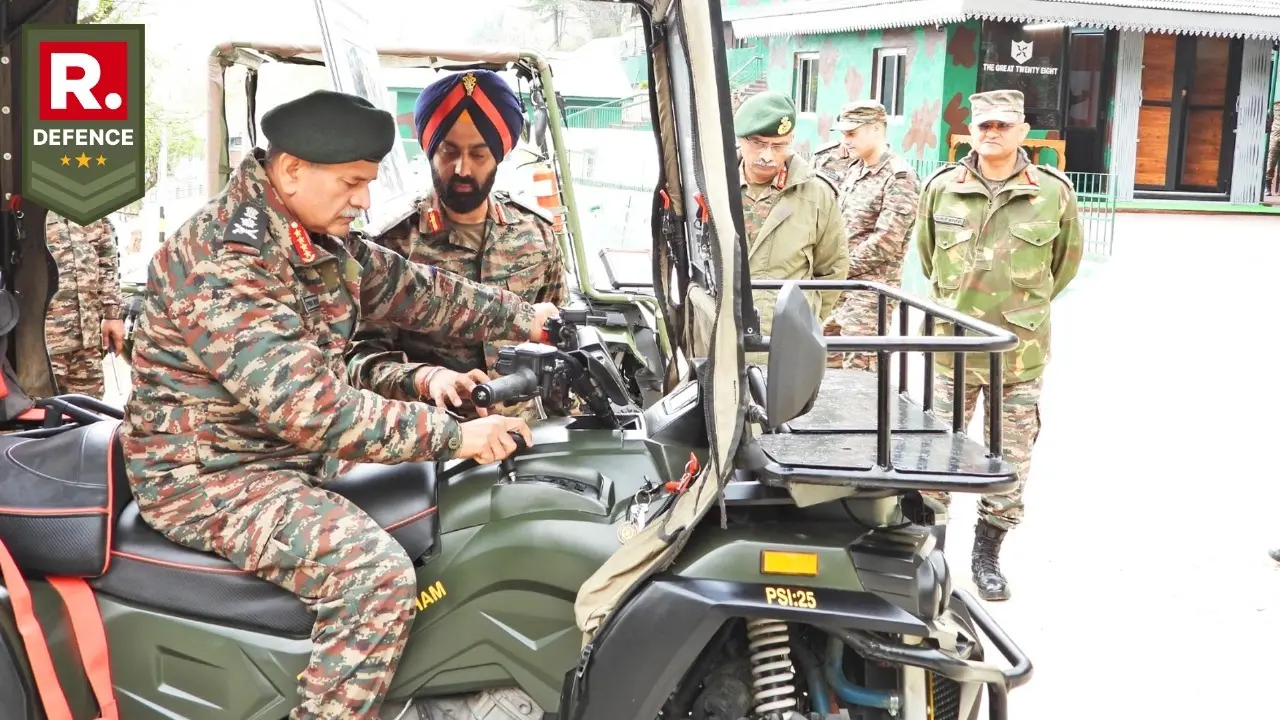Updated 9 April 2025 at 13:33 IST
General Dwivedi Reviews Strike Readiness of Indian Army’s Vajra and Dagger Divisions
General Upendra Dwivedi conducted a comprehensive field visit to Punjab’s Vajra Division this week, reinforcing the Army’s focus on frontline readiness.
- Defence News
- 5 min read

Jalandhar, Punjab – A quiet urgency marked the corridors of the Vajra Division headquarters on Tuesday as Chief of Army Staff General Upendra Dwivedi arrived for a frontline review of Punjab’s defence formations. Away from the glare of ceremony, the visit was all business—hours of briefings, operational maps, and frank conversations with commanders who live by the pulse of border tension. In a theatre that has seen history turn on a dime, the Army Chief’s focus was clear: assess, calibrate, and reassure.
Jalandhar’s Vajra Division, a bulwark under the Northern Command, stands sentinel over some of the most sensitive stretches of India’s western boundary. Alongside it, the Dagger Division complements the region’s defensive shield and offensive edge. Both formations operate in sync—one doesn’t blink without the other moving. During the visit, General Dwivedi received a detailed rundown of their operational preparedness. Every detail—from surveillance grids to QRT deployment timelines—was scrutinised. Behind the slides and models stood formations ready for scenarios that shift faster than the weather in the border belt.
The visit wasn’t just a review—it was a reaffirmation. In an era where threat vectors don’t always wear uniforms or move in convoys, the Army Chief’s interaction with commanders held deeper undertones. At the high-level security review meeting that followed, General Dwivedi and senior officers dissected Punjab’s current security scenario. Drone intrusions, narcotics corridors, state-sponsored mischief—no issue was off the table. And while much of the conversation remains classified, sources confirmed that contingency planning and civil-military coordination figured high on the agenda.
Punjab’s Corps Legacy Runs Deep in the Soil—And the Doctrine
The formations General Dwivedi reviewed are not new to pressure. XI Corps, which anchors the Vajra Division, was raised in 1950 at Ambala—barely three years after Independence—at a time when India was still drawing its maps and licking its wounds. By 1951, the Corps had shifted to Jalandhar, closer to the faultline. It was never a ceremonial move; proximity meant readiness, and readiness meant survival. Over the decades, XI Corps has adapted to everything from conventional face-offs to internal threats. When the burden grew, X Corps was raised in 1979 at Bathinda to take over the southern swathes of Punjab and northern Rajasthan.
Advertisement

But this isn’t just about old timelines and reorganisations. What stands today is a theatre ecosystem designed for rapid reaction and layered defence. The Vajra and Dagger Divisions don’t just man posts—they train to manoeuvre, intercept, and neutralise at short notice. And in a state where the border is a 30-minute drive from the cantonment, that readiness isn’t optional. It’s the norm.
From Kashmir to Punjab, The Army Chief Is Reading the Ground, Not the Briefs
Before Jalandhar, it was Srinagar. There, General Dwivedi also participated in operational assessments with the Chinar Corps. The message across both visits was consistent—field reality over PowerPoint optics. In Kashmir, the emphasis was on infiltration trends, hybrid threats, and valley stabilisation. In Punjab, it was border integrity, anti-drone drills, and intel loop closures. But in both places, the tone from the top remained grounded: preparedness isn’t seasonal, and complacency kills.
Advertisement

Army sources say the COAS has been personally reviewing the tempo of formations along the northern arc, especially as adversarial posturing remains fluid. From the icy watchposts of Sonamarg to the farmlands that straddle the barbed fence in Punjab, the Indian Army has recalibrated its presence with the mindset of "permanent contingency." That’s a doctrine where there is no such thing as peacetime—only varying levels of threat readiness.
Between Checkposts and Command Posts, a War-Ready Army Watches in Silence
The Vajra Division, in particular, has been quietly reinforcing its surveillance coverage, mobility corridors, and force dispersal drills. While the Army doesn’t share numbers, sources confirm that the formations now train for day-zero deployment scenarios—where troops are expected to be combat-ready within minutes of hostile action. The Dagger Division, too, has aligned its doctrine to support not just defensive containment but rapid counter-thrusts deep into any breach zone.
In a state like Punjab, where the enemy often arrives in bits—a drone, a packet, a signal—the military has retooled itself for a different kind of vigilance. It’s less about the spectacle of convoys and more about the discipline of anticipation. And in that space, Tuesday’s visit by the Army Chief was more than symbolic. It was a message—both inward and outward—that India’s western gate is not just manned, but watched, hardened, and ready.
As General Upendra Dwivedi wrapped up his visit, there were no grand soundbites or flashy declarations. Just the quiet confidence of a force that knows its ground trusts its formations, and prepares not for the war it wants—but the one it may have to fight.
Watch- Indian Army Troops Along Snow Clad LOC
Published By : Yuvraj Tyagi
Published On: 9 April 2025 at 13:33 IST
